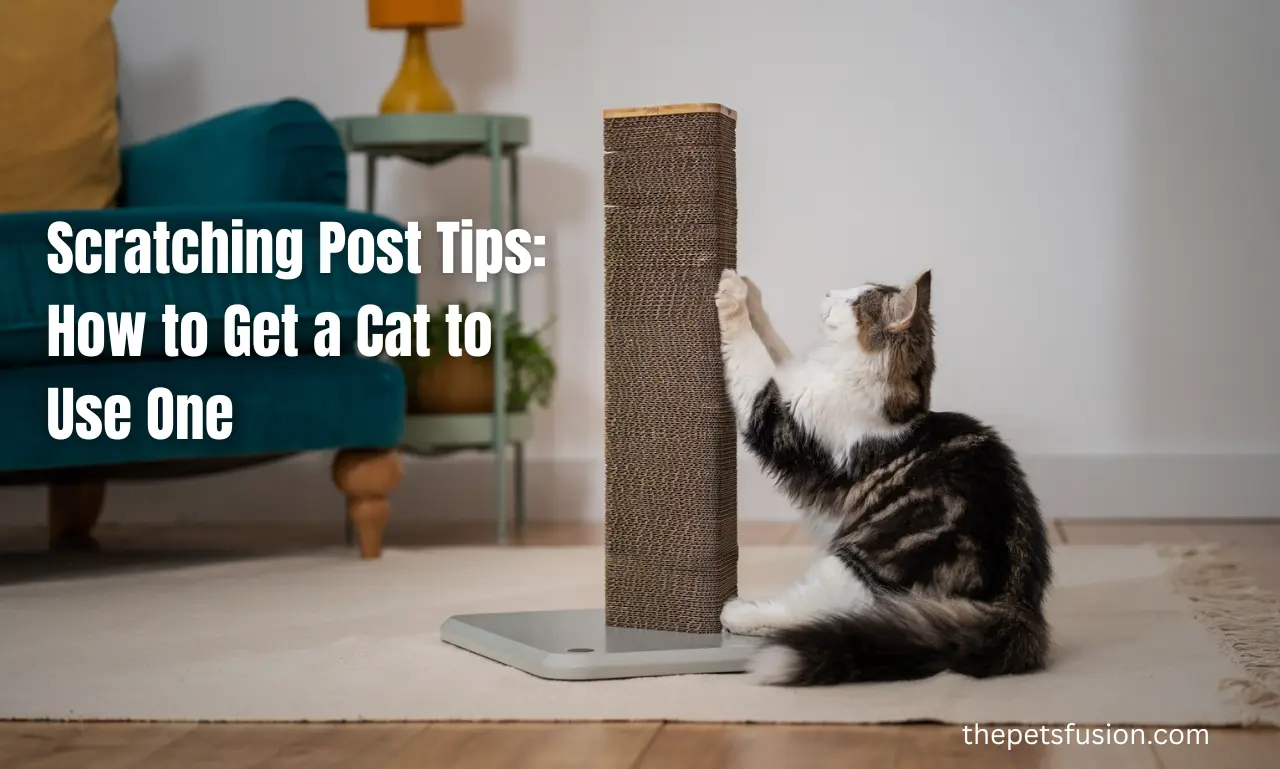Learning how to get a cat to use a scratching post starts with understanding your cat’s scratching instincts. Scratching is a natural, healthy behavior—not a problem to eliminate, but one to redirect. The proper setup, like a sturdy sisal scratching post or a few fun cardboard scratchers, can work wonders. With consistency and the appropriate placement, cats scratching posts become the go-to spot for your feline’s claws, not your furniture.
Why Cats Scratch
Scratching isn’t just a quirky habit—it’s a must for every CAT. When your feline digs into the side of your couch, it’s not mischief—it’s instinct. They’re doing precisely what nature designed them to do.
Claw Health
Scratching helps shed old nail sheaths and keeps those claws sharp, clean, and healthy.
Stretching
It’s like their version of yoga. Stretching out while scratching keeps their spine and muscles loose.
Territorial Marking
Cats have odor glands in their paws, so they leave their mark when they scratch.
Emotional Outlet
Whether they’re stressed, excited, or bored, scratching helps them blow off steam.
Once you understand why your cat scratches, it becomes much easier to guide that energy to the right spot.
The Problem with Furniture Scratching
Cats don’t know the difference between your expensive new loveseat and a tree trunk. So if they’re scratching up the furniture, it’s likely because you haven’t provided a better alternative, or placed it where they need it.
Here’s the kind of damage you’re likely to spot:
- Upholstery unraveling
- Carpet balding or fraying
- Wooden chair legs shredded
Solution? Create a more tempting target. That’s where cat scratching posts come into play.
Understanding Your Cat’s Scratching Instincts
Every cat has its quirks. Some scratch upwards, others sideways. Some love a good rough rope; others are all about cardboard.
Pay attention to:
- Vertical vs. horizontal habits
- Preferred locations (corners, doors, bedsides)
- Favorite materials (wood, fabric, rope, etc.)
The more you observe your cat, the better you understand what they naturally gravitate toward. This is where understanding your cat’s scratching instincts becomes gold.
Types of Cats Scratching Posts
There’s no one-size-fits-all. Here’s a quick breakdown of popular cats scratching posts to consider:
Sisal Scratching Post
Pros: Long-lasting, satisfying texture, great for energetic cats
Cons: Slightly more expensive than basic options
Best for: Daily use and stronger scratchers
Cardboard Scratchers
Pros: Inexpensive, recyclable, cats adore them
Cons: Wear out fast, messy
Best for: Kittens, senior cats, and casual scratchers
Carpet-Covered Posts
Pros: Soft, cozy look
Cons: Confusing message if you want them to avoid carpet
Wall-Mounted Scratchers
Pros: Save space, resemble tree trunks
Cons: Only suitable for vertical lovers
Scratching Pads and Mats
Pros: Portable, affordable
Cons: Limited for stretching
A mix can cater to multiple preferences, reducing boredom and behavioral issues.
Choosing the Right Scratching Post
Keep these in mind before buying:
- Height: Your cat should stretch fully without dangling.
- Stability: If it tips, your cat won’t trust it.
- Material: Sisal scratching posts and cardboard scratchers tend to get the most feline approval.
- Orientation: Vertical lovers need posts; horizontal lovers might prefer mats.
Sometimes, trial and error is the best approach. Start basic and upgrade based on the response.
Where to Place the Scratching Post
You wouldn’t work out if your gym were tucked behind the garage. Same with cats—they won’t use what they don’t see.
Best locations:
- Next to favorite nap spots
- By areas they already scratch
- In the main living space
Don’t stash the post in a back room. Make it part of the environment, like a plant or end table.
How to Introduce the Scratching Post
Don’t just plop it down and hope for the best. Make the post part of your cat’s daily fun.
Try these tips:
- Treat trail: Sprinkle or place treats on and near the post.
- Toy temptation: Tease your cat with a feather wand around the post.
- Catnip boost: If your cat responds to it, it’s a fantastic lure.
- Monkey see, monkey do: Lightly mimic scratching yourself—it works more than you’d think!
Training Techniques That Work
Let’s talk strategy. Here’s how to make that post a go-to:
Method 1: Positive Reinforcement
Catch your cat using it? Reward them immediately. Food, pets, praise—it’s all good.
Method 2: Redirection
Spot them clawing the couch? Gently pick them up, carry them to the post, and guide their paws.
Method 3: Make Furniture Less Fun
Furniture sprays or double-sided tape can repel claws—ensure they’re pet-safe.
Method 4: Build a Routine
Scratch sessions after meals or naps tap into their natural timing.
What to Do if Your Cat Ignores the Post
Don’t give up too fast. Some cats need the right post in the right place.
Try this:
- Switch materials—go from carpet to sisal scratching post or vice versa.
- Move the post closer to the action, not hidden away.
- Enrich the space—add toys, climbing shelves, and even a cat window perch.
- Use pheromone diffusers to ease anxiety that may be blocking behavior.
Alternatives and Add-Ons
If your post isn’t cutting it, mix things up:
Cardboard Scratchers
Easy to move, loved by many cats.
Wall-Mounted Posts
For vertical enthusiasts and tight living quarters.
Scratch Mats & Ramps
Ideal for horizontal lovers and older kitties.
Cat Trees with Scratching Zones
All-in-one fun—lounging, climbing, scratching.
Variety keeps things fresh and helps avoid furniture damage by diversifying their “approved” scratching zones.
DIY Scratching Post Ideas
On a budget or feeling crafty? Try this:
DIY Sisal Post
- Base: Flat wood panel
- Pole: Sturdy PVC or wood
- Wrap: Tightly wound sisal rope
- Tools: Glue gun, staple gun
- Optional: Hang a bell or toy for bonus appeal
DIY Cardboard Scratcher
- Cut multiple layers of cardboard
- Stack and glue them together
- Frame it with wood for polish (optional)
DIY gives you creative freedom—and cats love the effort (okay, maybe just the texture).
Long-Term Maintenance Tips
Your post won’t stay perfect forever. Keep it appealing:
- Snip off frayed sisal to avoid the mess
- Replace cardboard scratchers when they’re too worn out
- Move the post occasionally to refresh curiosity
- Vacuum and clean monthly to remove fur buildup
A well-kept post lasts years and keeps cats happy.
Common Mistakes to Avoid
- Punishing your cat: This backfires. Fear leads to hiding, not learning.
- I only have one post: Most homes need 2–3, especially multi-cat households.
- Hiding the post: Accessibility is key.
- Ignoring preferences: Let your cat’s behavior guide your decisions.
The more you observe and adapt, the better your results.
How do I Get My Cat to Use a Scratching Post
1. Choose the Right Material
Cats love rough textures. A sisal scratching post or cardboard scratchers are ideal choices.
2. Focus on Placement
Put the post near places your cat sleeps or where they scratch furniture.
3. Make It Attractive
Use catnip, treats, or hanging toys to draw attention to the post.
4. Use Positive Reinforcement
Reward your cat with credit or treats when they use the post correctly.
5. Be Consistent and Patient
Understanding your cat’s scratching instincts helps you stay patient while redirecting their behavior gently.
With time, your cat will prefer cats scratching posts over your furniture.
Frequently Asked Questions: How Do I Get My Cat to Use a Scratching Post?
1. Why won’t my cat use the scratching post?
Honestly, cats can be total divas about these things. If the post is wobbly, in a weird spot, or made from a texture they don’t love, they’ll ignore it. Try moving a sisal scratching post next to where they nap most often. A sprinkle of catnip can also work wonders.
What’s the best material for a cat scratching post?
Most cats are obsessed with sisal—it feels like tree bark, which they’d naturally scratch in the wild. Whether it’s sisal rope or fabric, it’s challenging and satisfying. That said, cardboard scratchers are great too, especially if your cat prefers horizontal scratching.
Should I get multiple scratching posts?
Absolutely. Think of it like giving them multiple comfy chairs around the house. A few cats scratching posts—some tall, some flat—let your cat choose what works for their mood. A little variety goes a long way.
Where should I place the scratching post?
Location matters. Put one near where they sleep (cats love a good post-nap scratch), near the furniture they’re already targeting, or anywhere they hang out often. The more visible the post, the better.
How do I stop my cat from scratching furniture without punishment?
Skip the scolding—it just stresses them out. Instead, when they go for the couch, gently guide them to the scratching post. Once they use it, throw in a treat or some praise. Positive reinforcement works way better than punishment.
Is it too late to train an older cat?
Not at all! Even senior cats can learn new scratching habits if the setup is correct. Just be patient, and make sure the post suits their needs. A good sisal scratching post with some encouragement can make all the difference.
Are cardboard scratchers good long-term?
Yep—mainly when used alongside more durable posts. Cardboard scratchers don’t last forever, but they’re cheap, cats love them, and they’re perfect for horizontal scratchers or loungers. Just be ready to replace them now and then.
Can I make my cat scratching post?
Definitely! A DIY sisal scratching post or homemade cardboard scratchers can be as effective. Make sure it’s sturdy and safe, with materials your cat already likes. Bonus points if you add a little toy or two.
What should I avoid when buying a scratching post?
Steer clear of short, unstable posts—they’re a turn-off for most cats. And be cautious with carpet-covered ones; they can confuse your cat and make real carpets fair game. A wobbly post is usually a hard no from felines.
Related: 300+ Cute Cat Names for Your Adorable Kitty: Find the Perfect Name!
Final Thoughts
Training your CAT doesn’t have to be a struggle. When it comes to how to get a Cat to use a Scratching Post, it all begins with understanding your cat’s scratching instincts. With a sturdy sisal scratching post, some fun cardboard scratchers, and the proper placement, your furry friend will gladly ditch the couch. Offering different cats scratching posts around the house makes scratching a joy, not a problem. Stick with it, stay positive, and reward progress. You’ve got this—and so does your cat. The results? Happy claws, safe furniture, and a stronger bond with your best buddy.






